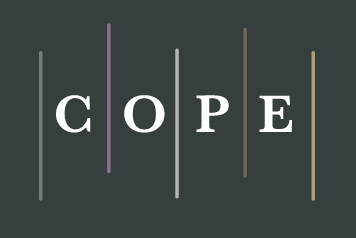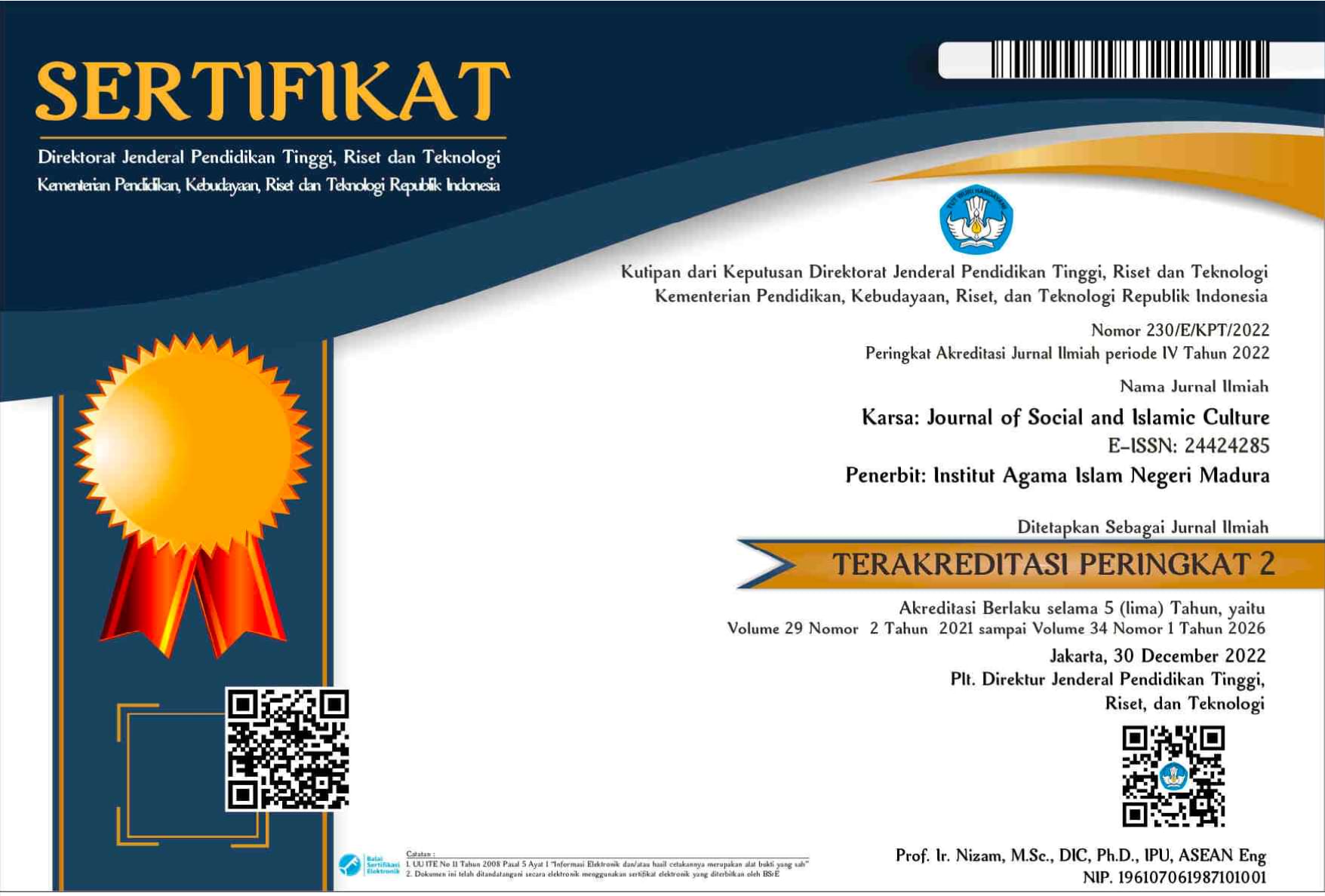Islam in Madurese’s Cosmological Interpretation: Structural Analysis of Tanean Lanjeng in Madura
 Abstract views: 282
,
Abstract views: 282
,
 PDF downloads: 311
PDF downloads: 311
Abstract
Madurese are known as devout Muslims. Islam and Madurese culture are two integrated identities like two sides of a coin. Islam and Madurese culture shape the value, word view and culture of Madurese people. Then, how significance are these two aspects in its cosmological order? What is Madurese’s cognitive structure in interpreting their world and forming a material culture? These questions are problems that will be revealed in this paper through research on Tanean Lanjeng, which is a typical settlement pattern in Madura. With Levi Strauss's structuralism approach, Tanean Lanjeng is seen as a code of conduct from the cognitive structure of the Madura people who formulate their ideas and actions. Tanean Lanjeng is a surface structure of a culture while the cognitive aspect is a deep structure. This paper further elaborates that the tanean lanjeng settlements in Madura not only have practical and social functions but show certain meanings that reflects the thinking and worldview of the Madurese. Values such as the equality of male and female relations, strong kinship ties, respect for certain figures, and Islam that are so deeply rooted in a structure that determines how Madurese behave, shape culture and interpret the world around them.
Downloads
References
Abdullah, Irwan. Konstruksi Dan Reproduksi Kebudayaan. Yogyakarta: Pustaka Pelajar, 2007.
Ahimsa-Putra, Heddy Shri. Strukturalisme Levi Strauss; Mitos Dan Karya Sastra. Yogyakarta: Kepel Press, 2006.
Amalia, Laili, and Hayat Hayat. “Penguatan Kapasitas Budaya Andeb Ashor dan Patronisasi Masyarakat Madura.” Jurnal Inovasi Ilmu Sosial dan Politik 1, no. 1 (2019): 38. https://doi.org/10.33474/ jisop.v1i1.2686.
Burhani, Ahmad Najib. Muhammadiyah Jawa. Jakarta: Al-Wasat Publishing House, 2010.
Fauzi, Muhammad Latif. “Actors and Norms in an Islamic Marriage: A Study of Madura Community in Rural Eastern East Java.” Journal of Indonesian Islam 13, no. 2 (2019): 297–325. https://doi.org/10. 15642/JIIS.2019.13.2.297-325.
Hastijanti, Retno. “Pengaruh Ritual Carok Terhadap Permukiman Tradisional Madura.” Dimensi Teknik Arsitektur 33, no. 1 (2005): 9–16.
Hefni, Moh. “Bhuppa’-Bhâbhu’-Ghuru-Rato (Studi Konstruktivisme-Strukturalis Tentang Hierarkhi Kepatuhan dalam Budaya Masyarakat Madura).” Karsa 11, no. 1 (2007): 13–20.
———. “Local Knowledge Masyarakat Madura; Ekologi Tegal di Madura.” Karsa 14, no. 2 (2008): 131–41.
Hidayat, Ainur Rahman. “Makna Relasi Tradisi Budaya Masyarakat Madura dalam Perspektif Ontologi Anton Bakker dan Relevansinya Bagi Pembinaan Jati Diri Orang Madura.” Jurnal Filsafat 23, no. 1 (2013): 21–32.
Jonge, Huub de. Madura dalam Empat Zaman Pedagang, Perkembangan Ekonomi dan Islam. Jakarta: Gramedia, 1989.
———. “Streotypes of the Madurese.” In Across Madura Strait: The Dynamics of an Insular Society, edited by Cornelis van Dijk, 23. Leiden: Koninklijk Instituut voor Taal-Land-en Volkenkunde (KITLV) Press, 1995.
Kuntowijoyo. Perubahan Sosial Dalam Masyarakat Agraris; Madura 1850-1940. Yogyakarta: Mata Bangsa, 2002.
Kuswandi, Iwan, and Lilik Fadilatin Azizah. “Tradisi Mitos Sangkal dalam Pertunangan Dini Perspektif Kiai di Madura.” Indonesian Journal of Islamic Literature and Muslim Society 3, no. 2 (2019): 157. https://doi.org/10.22515/islimus.v3i2.1391.
Muthmainnah. Jembatan Suramadu; Respon Ulama Terhadap Industrialisasi. Yogyakarta: LKPSM, 1989.
Paisun. “Dinamika Islam Kultural: Studi Atas Dialektika Islam dan Budaya Lokal Madura.” El-Harakah 12, no. 2 (2010): 154–68.
Pribadi, Yanwar. “Religious Networks In Madura Pesantren, Nahdlatul Ulama and Kiai as the Core of Santri Culture.” Al-Jami’ah: Journal of Islamic Studies 51, no. 1 (2013): 1–32.
Rifa’i, Mien A. Manusia Madura; Pembawaan, Perilaku, Etos Kerja, Penampilan Dan Pandangan Hidupnya. Yogyakarta: Pilar Media, 2007.
Ritzer, George, and Douglas J Goodman. Teori Sosiologi Modern. Jakarta: Prenada Media, 2003.
Ritzer, George, and Barry Smart. Handbook of Social Theory. London California, and New Delhi: Sage Publication Ltd., 2001.
Sadik, A. Sulaiman. “Revitalisasi Semangat Bhuppa’ Bhăbhu’ Ghuru Rato Dalam Melihat Madura Ke Depan.” Karsa 11, no. 1 (2007): 22–29.
Strauss, Claude Levi. Antropologi Struktural. Yogyakarta: Kreasi Wacana, 2005.
Susanto, Edi. “Ruh Islam Dalam ‘Wadag’ Lokal Madura: Kasus Tanean Lanjeng.” Karsa 14, no. 2 (2008): 142–47.
Tulistyantoro, Lintu. “Makna Ruang Pada Tanean Lanjang Di Madura.” Dimensi Interior 3, no. 2 (2005): 137–52.
Wiyata, A. Latief. Taneyan Lanjang: Pola Pemukiman dan Kesatuan Sosial di Masyarakat Madura. Jember: Pusat Kajian Madura Universitas Jember, 1987.
Wiyata, Latief. Carok: Konflik Kekerasan dan Harga Diri Orang Madura. Yogyakarta: LKiS, 2002.
Zuhri, Muhammad. “Persepsi Masyarakat Terhadap Kepemimpinan Formal Kepala Desa (Studi Kasus Tentang Perilaku Devian di Kabupaten Bangkalan, Jawa Timur).” UGM, 1991.
The journal operates an Open Access policy under a Creative Commons Non-Commercial Share-Alike license. Authors who publish with this journal agree to the following terms:
- Authors retain copyright and grant the journal right of first publication with the work simultaneously licensed under a Creative Commons Attribution License that allows others to share the work with an acknowledgement of the work's authorship and initial publication in this journal.
- Authors are able to enter into separate, additional contractual arrangements for the non-exclusive distribution of the journal's published version of the work (e.g., post it to an institutional repository or publish it in a book), with an acknowledgement of its initial publication in this journal.
- Authors are permitted and encouraged to post their work online (e.g., in institutional repositories or on their website) prior to and during the submission process, as it can lead to productive exchanges, as well as earlier and greater citation of published work.





















